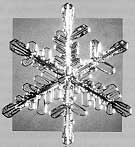Johannes Kepler, the yet-to-be famous astronomer, presented a unique New Year's gift to his patron in the winter of 1611. The scientist gave his benefactor a witty, reasoned discussion on why snowflakes (more exactly, ice crystals) have six corners. Since microscopes and diffraction instruments had not yet been invented, no one really knew why crystals took the shapes they did. Kepler 1 argued for the development of external shapes in crystals and other natural structures by the filling of three-dimensional space with atoms in various packing arrangements. He used analogies such as stacked cannon balls, bee hives, and packing of geometric shapes. Since he was unable to convince himself that the internal structure produced the external shapes, Kepler erroneously concluded that there is a "formative principle" which maintains six-cornered shapes. However, for his efforts to understand the cause of crystal shapes and his arguments which almost resulted in the correct explanation, he has been called by some "the father of crystallography."

Ice crystals are still being studied today. It is not completely clear, even now, why crystals grow into some of the beautiful shapes like the one shown. Since the growth of ice crystals seems to result in greater order, or decrease in entropy, some have attempted to justify the theory of evolution by an analogy to crystal growth. We will discuss the current research on ice crystal growth and why it does not support the theory of evolution.
THE MODERN EXPLANATION OF CRYSTAL SHAPE
The hexagonal symmetry of an ice crystal is an outward manifestation of an internal arrangement of the atoms in the ice. Each ice molecule is V-shaped with an angle of 109 degrees between the legs. Ice molecules are bound together in an open lattice and form puckered layers with hexagonal symmetry. Each molecule is surrounded by its four nearest neighbors, so that each group has one molecule at the center and the other four at the corners of a tetrahedron, all at the same distance away. The molecules are held in place mainly by electrostatic attraction between the positive charge of the hydrogen atom and the negative electrons of the neighboring oxygen atom. This is called a hydrogen bond.
Ice crystals grow as thin hexagonal plates or long hexagonal columns, depending on temperature. Two faces can be defined for ice crystals--the basal face and the prism face. The basal face if typically the surface which shows hexagonal symmetry. For example, the basal face in figure 1 is the surface facing the reader. Both the upper and lower surfaces are basal faces. The prism face is perpendicular to the basal face. It faces outward from an arm or portion of an arm. This face does not exhibit hexagonal symmetry. For some temperatures, the basal face grows faster than the prism face, resulting in long hexagonal columns or needles. At other temperatures, the prism face grows faster, resulting in thin hexagonal plates, fern-like stellar crystals, and dendrites like that shown in figure 1. The fern-like dendritic nature of crystals is caused by the humidity. The greater the humidity, the more feathery the crystals will appear.
Hallet and Mason 2 have explored the reasons the basal and prism faces grow at different rates as a function of temperature. They have discovered that vapor molecules collect on the surfaces and migrate across the surfaces to their final lattice positions. The rate at which the molecules migrate across the surface varies with temperature, and is different for the basal and prism faces. For some temperature ranges there is a net surface migration from the basal to the prism faces, resulting in a plate-like shape or habit. For other temperature ranges the situation is reversed, resulting in a net flux of molecules from the prism to the basal faces and the formation of columns or needles.
ORDER AND ENTROPY
The second law of thermodynamics states that the entropy of the entire universe always increases. The change in entropy can be defined in terms of heat flow, volume change, pressure change, energy available to do work, or order and disorder. Since we are talking about ordered arrangements of molecules in a crystal, we will discuss the concept of entropy primarily in terms of order and disorder. Entropy can be calculated by taking the logarithm of the number of different ways that a quantity of molecules can be arranged so that the arrangement looks the same to an observer. For example, suppose we have a box with a barrier in the middle. On one side are black molecules and on the other side white molecules. Now we take out the barrier and let them mix. How has the entropy changed? Feynman 3 in discussing this example asks, "How many ways could the molecules be distributed so that the white molecules are on one side of the box and the black molecules are on the other? On the other hand, how many ways could we distribute them with no restriction on which goes where? Clearly there are many more ways they could be distributed in the latter case." Feynman concludes that the entropy is greater when the molecules can be distributed. It is also evident that a box originally containing all black molecules on one end and white molecules on the other eventually will be evenly distributed throughout the box. The probability is so low that an original mixture of black and white molecules will separate with time into all black molecules at one end and white molecules at the other, that one never observes such an event.
With this understanding of entropy, then, we can better state the second law of thermodynamics. First, entropy measures disorder. Second, the universe always goes from order to disorder; the entropy of the universe always increases. Now, one of the first questions is whether entropy in an "open" local system can ever decrease. The second law only requires that the entropy for the entire universe always increases. If a local system undergoes a decrease in entropy, the surroundings must undergo an increase in entropy. Thus, either an increase or a decrease of entropy can occur in a local system. The issue is not whether a decrease in entropy can occur, but rather, what is occurring in the surroundings to cause the decrease in entropy?
For ice crystals to form, producing more order, heat must be extracted from the local system and added to the surroundings, or the surroundings must be made more disordered in some way. The agent for causing this ordering of a local system and disordering of the surroundings is the immediate or secondary result of an action by an agent separate from the system. This agent must do work to remove heat energy from the pre-coded structure of the water molecules and their associated hydrogen bonds.
Whenever the ordering of a local system results in beauty, symmetry, or function, this requires a pre-designed code, and does not happen by chance. Each physical agent operating at a higher level must function with greater order and power than the effect it produces. The ultimate cause which controls all secondary processes must have infinite power and organizing intelligence. Such a first cause is called God. Thus God either directly or by secondary processes produces order.
EVOLUTION AND THE SNOWFLAKE
The growth of crystals has been used as an analogy to support the theory of evolution. The argument is made that since the orderly growth of crystals is a natural process, the evolution of life proceeding from simple to more complex is also a natural process. However, we have shown that ice crystals only grow when an outside agent is driving the process against the natural decay process described by the second law of thermodynamics.
The theory of evolution suggests that increased organization has developed simply by random processes. Prigogine 4, for example, in attempting to make this argument, has stated ". . . in a non-isolated system there exists a possibility for formation of ordered, low-entropy structures at sufficiently low temperatures." However, random processes in the physical world always move in the direction of greater total disorder, according to the second law of thermodynamics. If simple physical processes like the mixing of gases always becomes more disorderly, why should complex biological processes naturally become more orderly? Prigogine (4), after attempting to demonstrate self-organization in non-equilibrium systems by random processes states, "Unfortunately, this (self-organization) principle cannot explain the formation of biological structures. The probability that at ordinary temperatures a macroscopic number of molecules is assembled to give rise to the highly ordered structures and to the coordinated functions characterizing living organisms is vanishingly small." Furthermore, crystal order results from the withdrawal of heat energy, whereas evolutionists argue that evolution sustains itself by the addition of heat energy from the sun. The two are not analogous at all. Still further, evolution is supposed to be open-ended, continuing indefinitely its growth in order, whereas a crystal, once formed deterministically by the pre-coded system which produced it, is at a dead end, and can go no further toward higher order.
Biblical Christianity, on the other hand, is in perfect agreement with the observation of order in the universe and its decay with time. Nowhere is there any evidence in the Bible, or elsewhere, that order slowly increases over long periods of time by the process of biological evolution, or any other chance phenomenon.
CONCLUSIONS
The growth of ice crystals does not provide evidence to support the theory of evolution. Ice crystal growth is consistent with the second law of thermodynamics, and both are evidences for God's oversight and care for His creation. God is a God of beauty and order, and wishes for us to study His creation to learn more about Him. He asks us to consider these questions further, when He says, "Have you entered into the treasures of the snow?" (Job 38:22).
REFERENCES
1 Kepler, Johannes, The Six-cornered Snowflake, edited by Colin Hardie, Oxford Press, 1966, 74 pp.
2 Hallett, J. and B.J. Mason, "The influence of temperature and supersaturation on the habit of ice crystals grown from the vapour," Proc. Royal Soc. A247, 1958, p. 440.
3 Feynman, R.P., R.B. Leighton, and M. Sands, The Feynman Lectures on Physics, Addison-Wesley, 1963, Chapter 46, pp. 1-9.
4 Prigogine, Nicolis, and Babloyants, "Thermodynamics of Evolution," Physics Today, vol. 25, no. 11, 1972, pp. 23-28.
Larry Vardiman, Ph.D., is Acting Head of the Astro/Geophysics Department at ICR as well as Head of Physical Sciences at Christian Heritage College.



















